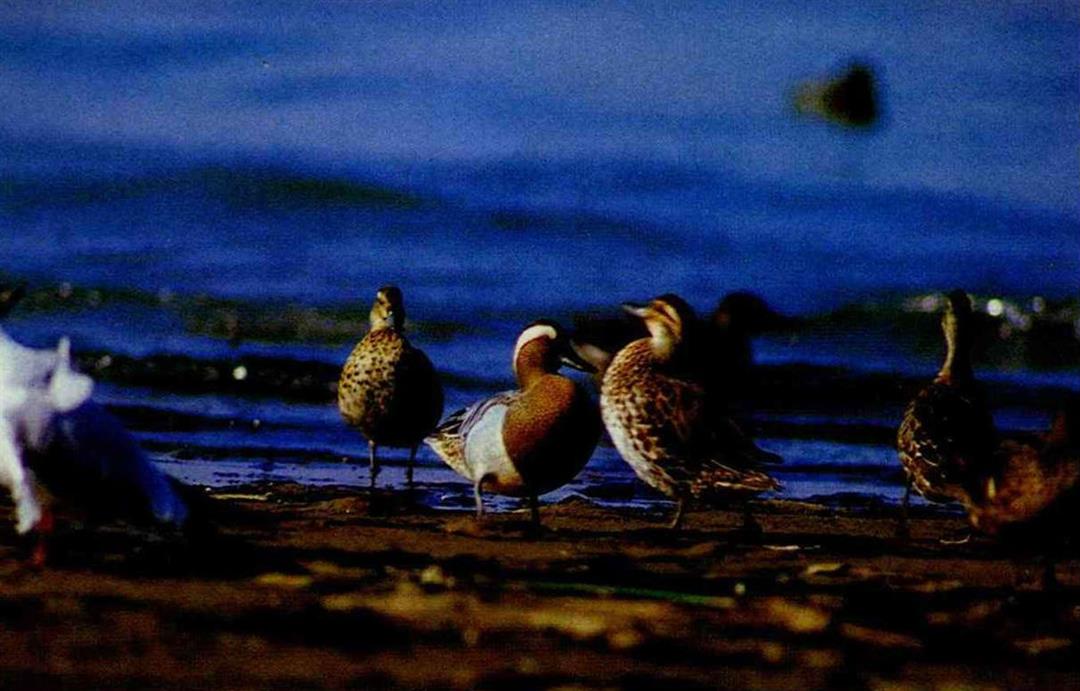Every winter thousands of wild ducks leave their homes in the north and fly over mountain and sea to pass the winter in semitropical Taiwan. Nearly half of these avian visitors gather at a bird sanctuary near Hwachiang Bridge on the Tamsui River. This January members of the Wild Bird Society of Taipei counted about 3,400 visiting ducks in the sanctuary, the most in history, and a record number of species, fifteen.
In addition to commonly seen species, such as hsiaoshuiya(Anas falcata), p'itsuiya (Anas clypeata), and chienweiya (Anas acuta), which visit the island regularly, some rare species normally seen only in photographs, including tufu (Tadorna ferruginea), huafu (Tadorna tadorna), paya (Anas formosa), and ch'ingt'ou ch'ienya (Aytlya marila), were also sighted, to the delight of local bird watchers. The sighting of the ch'ingt'ou ch'ienya was a particular surprise, since the species had never appeared on Taiwan before. Hearing the news, bird lovers streamed to the sanctuary to catch a glimpse of their feathered friends.
Because the ducks' mating season was about to arrive, the males had donned bright and colorful feathers, and each species look different, their heads decorated as though they were wearing make-up for Chinese opera. The two thick white eyebrows of the paimeiya (Anas quelquedula) were especially striking.
Besides playing in the water and soaring in the air, the ducks' most important purpose for staying on Taiwan was to eat their fill, rest, and recuperate, and then fly back home to propagate. Different species have different ways of foraging for food: some twist their heads about looking for algae on sand bars; some stretch their necks into the water and search for minnows and shrimp; and some immerse themselves under water, leaving only the tips of their tails splashing about on the surface, creating picture after picture of interesting effects.
To be able to see wild ducks living in a natural situation without having to trek for away from the city is certainly a great joy for nature lovers. The area around Hwachiang Bridge, explains Fang Wei-hung, a member of the Wild Bird Society, is suitable for the ducks because the river there is broad and slow and has formed numerous bars from the mud and silt brought down from upstream. As the tide retreats, the ducks like to stick their bills into the mud and sand and seek for algae, shells, insects, or other kinds of food.
A suitable ecological environment is one of the reasons why the ducks choose to stay in the area. But there are a number of similarly suitable environments on Taiwan's western coast, so why do they mostly gather at Hwachiang Bridge?
"It doesn't mean that this area is ideal for the ducks--only that suitable places are getting fewer and fewer," Fang Wei-hung says. Kuantu used to be another major resting place for the ducks, too, but the tidewater belt there has been gradually grown over by mangroves, and the ducks have been disturbed by increased fishing boat traffic. And the number of seasonal birds that appear at Lanyang Creek near Ilan has declined over the years because of overzealous hunters and fishermen. So Hwachiang Bridge may simply be a last refuge for frightened ducks.
Like other migratory fowl, the ducks come south to Taiwan every year following the northeast seasonal winds, and they prepare to return home between March and May, when the weather gradually warms and the wind starts to blow out of the southwest.
That's the time when we must bid farewell to this group of lovely wildfowl. And when the northeast seasonal winds start to blow again this winter, will the ducks still appear at Hwachiang Bridge? And how many will come? No one can say.
Ducks may be small, but they are no different from humans in their sensitivity to the state of the environment. What grade should we receive for our hospitality? We'll get an answer this winter.
[Picture Caption]
tufu (Tadorna ferruginea) and hsiaoshuiya (Anas crecca).
Shucks, caught me stretching, did you?
It's not that I don't know my manners.
It's just that during a warm March on Taiwan.
It feels real good to give your wings a shake.
Watching the ducks by Hwa-chiang Bridge. (photo by Arthur Cheng)
Hey, how come we haven't reached shore yet?
My neck is sore and my wings are tired.
It's sure not easy trying to pass a warm winter.
huafu (Tadorna tadorna), male.
kaoch'iaoheng (Himantopus himantopus).
chienweiya (Anas acuta).
What's she strutting about like that for?
Quack, quack, quack! It's really shameless.
I'm only trying to let that guy with the white eyebrows see
I'm not bad looking.
paimeiya (Anas quelquedula). The duck with the white eyebrows is a male.
tufu (Tadorna ferruginea).
Ow! Almost wrenched my neck.
Hey little bug, don't run away!
Let me eat up so I'll be strong enough to fly home.
p'itsuiya (Anas clypeata).

Shucks, caught me stretching, did you?

It's not that I don't know my manners.

It's just that during a warm March on Taiwan.

It feels real good to give your wings a shake.

Watching the ducks by Hwa-chiang Bridge. (photo by Arthur Cheng)

Hey, how come we haven't reached shore yet?

My neck is sore and my wings are tired.